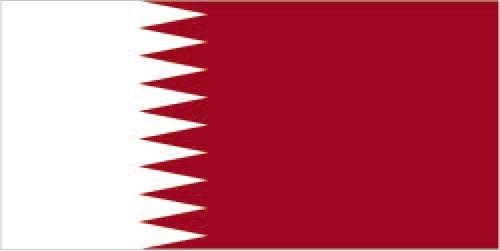161 Qatar

Maroon with a broad white serrated band (nine white points) on the hoist side. Maroon represents the blood shed in Qatari wars, white stands for peace. The nine-pointed serrated edge signifies Qatar as the ninth member of the “reconciled emirates” in the wake of the Qatari-British treaty of 1916.
Flag courtesy of the CIA World Factbook

Map courtesy of the CIA World Factbook

Old city of Doha, January 1904
Government
According to Britannica, a constitutional emirate with one advisory body, Qatar is ruled by a hereditary emir from the Āl Thānī. Members of the ruling family hold almost all the major ministerial posts, which are appointed by the emir. The family, however, is large and fragmented. As oil revenues rose after World War II, contention within the ruling family grew, and there have been several bloodless palace coups.
The emir’s power is constrained by the need to maintain the support of important family members, many of whom occupy high governmental posts. The homogeneity of the ruling family and the country’s wealth contribute to Qatar’s political stability. The emir has also cautiously expanded political participation, allowing the first municipal elections to take place in 1999, with an electorate that included both female and male Qataris. Under a provisional constitution enacted in 1972, the emir ruled in consultation with a Council of Ministers (Majlis al-Wuzarāʾ) and an appointed Advisory Council (Majlis al-Shūrā). A new constitution, which was approved by referendum in 2003 and enacted in 2005, provided for the popular election of two-thirds of the members of the Advisory Council.
Qatar’s legal system has several sources: the Sharīʿah (Islamic law), Ottoman law, and European civil and (to a lesser extent) common law. The latter was introduced through the borrowing of codes of other European-influenced Arab states. Personal status law is governed largely by the Sharīʿah, while criminal law is influenced but not governed by it. In addition to a Higher Judicial Council, there are also several lower courts and a system of appeals courts. The emir sometimes acts as the final court of appeal. Formal civil and criminal codes were introduced in the 1970s.
Qatar Civil Aviation Authority (QCAA)
Qatar Civil Aviation Authority (QCAA) was established in 2001 in accordance with Law No. (16) of 2001. QCAA works to implement the provisions of Civil Aviation Law No.(15) of 2002, later amended in 2008 and 2011 in accordance with the requirements and developments in the Aviation sector locally, regionally and globally. QCAA is a legal entity and it is allocated a budget affiliated with the budget of the Ministry of Transport. The vision of QCAA is to maintain a safe, effective and sustainable civil aviation system that enhances the status of Qatar on the map of the international civil aviation industry.
Airspace
SkyVector – Google Maps – ADS-B Exchange
ICAO countries publish an Aeronautical Information Publication (AIP). This document is divided into three parts: General (GEN), En Route (ENR) and Aerodromes (AD). ENR 1.4 details the types of airspace classes they chose to adopt from classes A through G.
Drone Regulations
2023
AIRAC AIP SUP 13/2023 – REMOTELY PILOTED AIRCRAFT SYSTEM (RPAS)/DRONE OPERATIONS WITHIN DOHA FIR
2021
Drone Registration Application (Individuals) – Form UA Reg 01
Drone Registration Application (Companies) – Form UA Reg 02
Drone Registration Application (Government/Semi-Government) – Form UA Reg 03
Request to change ownership of a drone – Form UA Reg 04
Request to cancel the registration of a drone – Form UA Reg 05
Renewing a drone’s registration – Form UA Reg 06
Advanced Air Mobility (AAM) Regulations & Policies
None found by the author.
However, should you, the reader, happen to stumble across something to the contrary, please email the author at FISHE5CA@erau.edu and you may be mentioned in the ACKNOWLEDGEMENTS section of this book by way of thanks for contributing to this free eBook!
Advanced Air Mobility (AAM) News
2025
Video courtesy of Advanced Air Mobility Institute from the January 2025 Global AAM Forum. Complete session for Day 2 of this Forum is available on the Advanced Air Mobility Institute YouTube Channel
2024 – Qatar Plans to Test Air Taxi & Electric Delivery Planes
2024 – Qatar government plans to test eVTOL air taxis in early 2025
Short Essay Questions
Scenario-Based Question
You have been hired by a Drone Startup Company. Your boss has immediately assigned this job to you.
They need you to prepare a one-page memo detailing the legalities of using a drone to film the Barzan towers, just outside the city of Doha.
They need you to mention any national laws and local ordinances.
They specifically want to know what airspace (insert pictures) you will be operating in and whether or not you need an airspace authorization.
Does it matter whether or not you are a citizen of the country?
Lastly, there is a bonus for you if, as you scroll through this chapter, you find any typos or broken links!
Short Essay Questions
- What are the drone categories?
- How is registration addressed?
- How is remote ID addressed?
- What are the model aircraft rules?
- What are the commercial drone rules?
- Are there waivers or exemptions to the rules? If so, for what?
- Would you share a link to an interactive airspace map?
- How is BVLOS addressed?
- How can you fly drones at night?
- How can you fly drones over people?
- Where do you find drone NOTAMs?
- What are the rules for drone maintenance?
- What are the rules for an SMS program?
- What are some unique rules not mentioned above?
- What are the C-UAS rules?
- What are the AAM rules?

